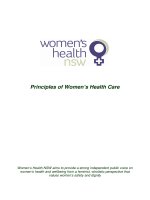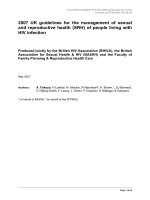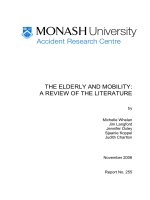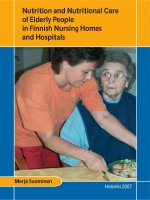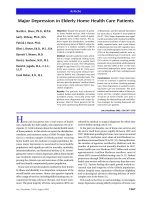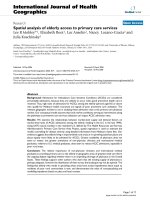Interim Review of Elderly Health Care Voucher Pilot Scheme docx
Bạn đang xem bản rút gọn của tài liệu. Xem và tải ngay bản đầy đủ của tài liệu tại đây (2.27 MB, 136 trang )
Inte rimReviewof
ElderlyHealthCareVoucher
PilotScheme
FoodandHealthBureau
DepartmentofHealth
February2011
GovernmentofHongKong SpecialAdministrativeRegion
ElderlyHealthCareVoucherPilotScheme:AnInterimReview
Cont en t
EXECUTIVESUMMARY I
PURPOSE 1
BACKGROUND 1
POLICYADDRE SS
1
SCHEMEOBJECTIVE S
1
IMPLEMENTATION 2
SCHEMEDESIGNANDFEATURES
2
ElderlypersonseligibletoparticipateintheScheme 2
Healthcare serviceproviderseligibletoparticipateintheScheme 2
Restrictionsontheuseofhealthcarevouchers 2
SCHEMEOPERATION
3
Mechanismforissuingandusinghealthcarevouchers 3
Arrangementforreimbursementofhealthcarevouchers 4
eHealthSystem 4
PrivacyImpactAssessmentandPrivacyComplianceAssessment 5
SecurityRiskAssessmentandAudit 6
Theelectronic platformpilotingamodelforschemeadministration 6
IMPROVEMENTMEASURES
7
Datainputofclaimtransactions 7
ModificationtoConsentForm 7
NoneedtoarrangeVoucherAccountCreationForm 8
UseofSmartIdentityCardReader 8
PUBLICITYANDPROMO T IO N
9
REIMBURSEM E NT
10
POST‐CLAIMCHECKINGANDAUDITING
10
MeasurestopreventabuseoftheScheme 11
TheCorruptionPreventionDepartmentofIndependentCommissionAgainstCorruption 12
TheAuditCommission 12
INTERIMREVIEW
13
Objectivesoftheinterimreview 13
Methodologyandsourceoffindings 13
ElderlyHealthCareVoucherPilotScheme:AnInterimReview
STATISTICSONPA RTICIPATIONANDUTILIZATION 15
METHODOLOGY
15
RESULT S
15
(A)
Statisticsonhealthcareservicepro viders 15
Numberofenrolledhealthcareserviceproviders
15
Distributionofplacesofpractice
15
Enrolmentamonghealthcareprofessionals
18
Participationamonghealthcareprofessionals
20
Enrolmentandwithdrawalofhealthcareprofessionals
21
(B)Sta tisticsontheelderly 23
NumberofelderlypeoplejoiningtheScheme
23
(C)Voucherutilizationpattern 23
NumberofeHealthaccountscreated
23
Numberofclaimtransactionsmade
25
NumberofeHealthaccountswithzerobalanceofvoucher
25
Distributionofclaimtransactionsamonghealthprofessions
25
Distributionofclaimtransactionsbyreasonofvisit
27
Numberofvouchersusedpertransactionbytheelderly
29
Numberofvouchersclaimedbyhealthprofession
31
Medianofvouchersclaimedpertransactionbyhealthprofession
33
Distributionofvouchersclaimedandtransactionsmadebymedicalpractitioners
34
Doctor‐patientrelationship
35
FEEDBACKFR OMTHEELDERLY 37
OPINIONSURV EY
37
METHODOLOGY 37
RESULT S 37
(A) Reasonsforusingvouchers 38
(B) Schemeawareness 40
(C) Schemescope 43
a.
Subsidyamount 43
b.
Ageeligibility 44
c.
Coverageofhealthservices 44
(D) Scheme delivery 45
(E) Schemeimpact 46
a.
ChoiceofhealthcareservicesafterSchemelaunch
46
b.
ChangeinservicefeesafterSchemelaunch
47
ElderlyHealthCareVoucherPilotScheme:AnInterimReview
WILLINGNESS‐TO‐PAY
STUDY
49
METHODOLOGY 49
RESULT S 49
(A) Willingnesstopay 50
(B) Willingnesstoco‐pay 52
(C) Subsidy 54
FEEDBACKFR OMHE ALTHCARESERVICEPROVIDERS 56
METHODOLOGY
56
RESULT S
56
(A)
Reasonsforchoiceofparticipation 56
(B)
Schemedelivery 56
(C)
Schemeimpact 57
(D)
Suggestionsfr o mhealthcareserviceproviders 57
CONCLUSIONSANDRECOMMENDATIONS 58
KEYOBSERVATIONSONTHESCHEME
58
(i) Schemeawarenessandparticipation 58
(ii) SatisfactionwiththeScheme 59
(iii) Impactonhealthcareseekingbehaviour 60
(iv) Priceandsubsidyforhealthcareservices 62
(v) Coverageofhealthcareserviceproviders 63
RECOMMENDATIONS
63
APPENDIX1‐“FULLVERSION”AND“COND E NSEDVERSION”OFCONSENTFORMSINEHEALTHSYSTEM
68
APPENDIX2‐LISTOFDISTRICTELDERLYCOMMUNITYCENTRESANDNEIGHBOURHOODELDERLY
CENTRESHOMES 72
APPENDIX3–PROTOCOLSONMONITORINGANDINVES TIG ATIONOFTRANS ACTIO N CLAIMSMADE
THROUGHTHEEHE ALTHSYSTEM 77
APPENDIX4‐LISTOF“REASONOFVISIT”INRESPE CTOFTHEHEALTHCAREPROFESSIONALSELIGIBLETO
JOINTHESCHEME 86
APPENDIX5–FREQUENCYDISTRIBUTIONOFAVERAGENUMBEROFVOUCHERSCLAIMEDPER
TRANSACTIONBYHEALTHPROFESSION 92
APPENDIX6–FREQUENCYDISTRIBUTIONOFVOUCHERSCLAIMEDBYHEALTHPROFESSION 102
ElderlyHealthCareVoucherPilotScheme:AnInterimReview–ExecutiveSummary
i
EXECUTIVE SUMMAR Y
TheElderlyHealthCareVoucherPilotScheme(theScheme)hasbeen
in place for two years since its implementation in 2009.To assess the
effectiveness of the Scheme in enhancing primary care for the elderly, the
Government initiated an interim review in the second half of 2010.The
operationof
theSchemeandutilizationofthevoucherswereexamined.The
opinions and feedback of the elderly and healthcare service providers were
collected.Thisexecutivesummaryhighlightsthemajorfindingsofthereview,
ourevaluationoftheextenttowhichtheSchemehasachieveditsobjectives,
andourrecommendationsontheway
forwardwhenthecurrentpilotperiod
endson31December2011.
SchemeObjectives
2. The Chief Executive announced in the 200 7‐08 Policy Address that
the Government would launch a three‐year pilot scheme in the 2008‐09
financial year under which elderly people aged 70 or above would be
given
annually five health care vouchers worth $50 each to subsidise the primary
healthcare servicestheypurchasefromthe private sector.The Schemewas
launched on 1January 2009.It aims at providing partial subsidies for the
elderly to receive private primary healthcare services in the community, as
additional choices on
top of the existing public primary healthcare services,
with a view to enhancing primary healthcare services for the elderly.The
Scheme implements the “money follows patient” concept on a trial basis,
enablingelderlypeopletochoosewithintheirneighbourhoodprivateprimary
healthcareserv icesthatbestsuittheirneeds.
3. By
providing partial subsidies for the elderly to choose priva te
primary healthcare in the community, it is expected that the Scheme could
help promote key ingredients of good primary care among the elderly and
healthcare service providers, including: continued relationship between the
elderly and their healthcare providers, more provision and utilization of
preventivehealthcareservices,andpromotionofwell‐beingamongtheelderly.
With better access and a continuum of care from participating healthcare
serviceproviders,weexpectthatmoreelderlypeoplewouldbeabletochoose
private primary healthcare services close to their homes, and those elderly
peoplewhoneedto
relyonpublichealthcareservicesmightalsobenefitfrom
ElderlyHealthCareVoucherPilotScheme:AnInterimReview–ExecutiveSummary
ii
thelessburdenedpublicprimarycareservices.
ScopeandMethodologyoftheInterimRevie w
4. The interim review was conducted when the Scheme has been
implementedforitsfirst halfofthepilotperiod.Effortshave been madeto
show the position up to 31 December 2010, save for situations where
only
dataup to31October2010wereavailableforanalysispurposes.
5. Thescopeoftheinterimre viewcoverstheoperationof theScheme,
participation in the Scheme, utilization of vouchers, and feedback on the
Schemeingeneralandspecificaspects.Inparticular,theinterimre viewhas
coveredthe
followingaspectsby–
(a)examiningvoucherutilizationbytheelderlyandparticipationof
healthcareserv iceprovidersintheScheme;
(b) collecting feedback from the elderly (both participating and
non‐participating) about the Scheme, including their awareness
of the Scheme, means to get to know the Scheme, reasons for
Scheme
participation / non‐participation, desirable subsidy
amount, ag e eligibility, healthcare services coverage, service
deliveryandperceptionaboutchangeinservicefeesandchoice
ofhealthcareser viceafterSchemelaunch;and
(c) collecting feedback from healthcare service providers (both
enrolledandnon‐enrolled)abouttheScheme,includingscheme
operation, service delivery, barriers
of non‐participation and
reasonsforwithdrawal.
6. Data collected for analysis and examination include statistical data
capturedin the databaseof theeHealthSystem and purposelycollecteddata
throughstructuredquestionnaires and focusgroupdiscussions.To this end,
studies were conducted by the School of Public Health and Primary
Care of
FacultyofMedicineoftheChineseUniversityofHongKongtocollectfeedback
from the elderly and healthcare service providers, viz. the opinion survey,
focusgroupdiscussionsandthewillingness‐to‐pa ystudy.
ElderlyHealthCareVoucherPilotScheme:AnInterimReview–ExecutiveSummary
iii
SchemeOperationandIm plementatio n
eHealthSystem
7. The Scheme is administered through an electronic platform, viz. the
eHealth System.It is a web‐based system on which voucher‐based and
subsidy schemes operate.There is no need to issue or carry vouchers in
paper form as vouchers are issued and used through the electronic system.
The
eHealthSystemperformsthefollowingfunctions‐
(a) managing information on healthcare service providers and
enrolment;
(b) managing health care voucher accounts, including registering
eligible elderly people under the Scheme, issuing vouchers,
processingclaimsandrecordingusage;
(c)managingreimbursementof healthcare vouchersonamonthly
basis;and
(d) monitoring
the Scheme by producing statistical reports to
facilitate planning and management of dai l y operation, and
generatingalertmessageswheneveranirregularityintheuseof
vouchers is det ected to facilitate follow‐up actions and
investigations.
UseofSmartIdentityCardReader
8. Tofurtherstreamlineproceduresandprovidegreaterconvenienceto
healthcare service providers, arrangements have been made in late 2010 to
makeuseofthe“cardfacedata”functioninthechipsoftheSmartHongKong
Identity Card (HKID) for registration and authentication.It provides an
alternative means to
participating healthcare service providers to register
persons eligi b le for vouchers and to access their accounts for claiming
vouchers,obviatingmanualinputandensuringdataaccuracy.
ElderlyHealthCareVoucherPilotScheme:AnInterimReview–ExecutiveSummary
iv
PrivacyImpactAssessmentandPrivacyComplianceAssessment
9. Measurestoprotectpersonaldataprivacyandtopreventabusehave
been instigated prior to and during Scheme implementation.A Privacy
Impact Assessment (PIA) and a Privacy Compliance Assessment (PCA) on the
design and operational procedure s of the Scheme (phase I) were conducted
between July and December 2008 by
Deloitte Touche Tohmatsu.This
ensuresthattheeHealthSystemhasbuilt‐infeaturestosafeguardthesecurity
of personal data transferred and stored within it in compliance with the
relevantlegislationandgovernmentguidelinesonprotectionofpersonaldata
privacy.Prior to full launch of Smart HKID deployment for eHealth account
creationandvoucherclaimsinO ctober2010,PIAandPCAonphaseII ofthe
eHealthSystemwereconductedbetweenAprilandJuly2010.
SecurityRiskAssessmentandAudit
10. In addition, the Department of Health (DH) engaged Computer and
TechnologicalSolutionsLimited(C&T)toconductSecurityRiskAssessmentsof
phaseIandIIoftheeHealthSysteminMay2008andJune2010respectively.
The current security risk level of eHealth System was found satisfactory, and
compliedwith
theGovernment’sITSecurityPolicyandSecurityRegulations.
Post‐claimcheckingandAuditing
11. As at 31 December 2010, a total of 852,721 claim transactions
involving2,136,630voucherswereprocessedforreimbursementandatotalof
about $106 million have been reimbursed to enrolled healthcare service
providers.Toensureproperdisbursementoffundingforvoucherclaims,DH
has put in place a mechanism
for checking and auditing voucher claims.It
involves (a) routine checking, (b) monitoring and investigation of aberrant
patterns of transactions, and (c) investigation of complaints.By end
December 2010, a total of 1,711 inspection visits were conducted, having
30,241claimscheckedwhichre presents4%ofclaimtransactionsmade.The
checkingcovers
77%ofenrolledhealthcareserviceproviderswithclaimsmade.
The post‐claim checking and auditing revealed 25 cases of wrong claims,
representing 4% of the checked claims.These claims involved error s in
procedures or documentation.So far, two medical practitioners and one
Chinesemedicinepractitionerhavebeendelistedfromthe
Scheme.
ElderlyHealthCareVoucherPilotScheme:AnInterimReview–ExecutiveSummary
v
12. In mid 2008, the Corruption Prevention Department of the
Independent Commission Against Corruption offered corruption prevention
advicetoDHontheadministrationoftheSchemepriortoitslaunch.Also,to
ascertainwhethertherearepotentialriskstoregularity,proprietyorfinancial
controlinthemanagementoftheScheme
anditsoperationalmechanism,the
AuditCommissionconductedariskauditoftheSchemein2009‐10.DHhas
taken into account their suggestions and observations in fine‐tuning the
modusoperandioftheScheme.
Sta tisticsonSchemeParticipationandU t ilization
Healthcareserviceproviders:distributionofplacesofpractice
13. Asat31December2010,thereareatotalof2,736healthcareservice
providersenrolledintheScheme,involving3,438placesof practice.Among
them, 39.6% (1,363) are in Kowloon, 23.4% (803) Hon g Kong Island, 19.8%
(681)theNewTerritoriesWest,16.0%(549)theNewTerritoriesEastand1.2%
(42)Islandsdistrict.Ofthe18districts,YauTsimMongdistrict(549)hasthe
highestnumberofplacesofpractice.
Healthcareserviceproviders:Enrolmentandparticipationrate
14. Nine categories of healthcare professional who are registered in
HongKong are eligible to participate in the Scheme.They are medical
practitioners, Chinese medicine practitioner s, dentists, chiropractors,
registered and enrolled nurses, physiotherapists, occupational therapists,
radiographers and medical laboratory technologists.Medical practitioners
account for the highest percentage of enrolled healthcare
service providers
(52.3%)(1,431),followedby Chinesemedicinepractitioners(27.9%)(762)and
dentists(8.7%)(239).
15. We estimate that the participation of medical practitioners, which
formed the majority of the enrolled healthcare services providers, is about
34.1% of the potential pool of medical practitioners actively providing
healthcareservicesintheprivate
sector.Theparticipationrateisonparwith
other public‐private partnership schemes launched by the Government (e.g.
vaccination subsidy schemes).Participation among other eligible health
ElderlyHealthCareVoucherPilotScheme:AnInterimReview–ExecutiveSummary
vi
professions is relatively lower, at 16.1% for dentists and 12.5% for Chinese
medicinepractitioners.
ElderlypeoplejoiningtheSchemeandclaimingvouchers
16. As at 31 December 2010, a total of 385,657 eHealth accounts
(representing 57% of eligible elderly people) were created and 300,292
eHealth accounts made voucher claims (representing 45% of eligible elderly
people).Thenumberof eligibleelderlypeoplewhohaveregisteredwiththe
Scheme has increased from 42% in
end 2009 to 57% in end 2010.The
number of eligible elderly people who have registered with the Scheme and
made voucher claims has increased from 29% to 45% over the same period.
By the end ofthesecondyear ofthe pilotperiod,131,801elderlypeople,or
34%ofelderly
peoplewhohaveregisteredwiththeScheme(some20%ofthe
eligibleelderlypeople),usedupthevoucherstheywereentitledtobythen.
Claim transactions made: distribution among health professions, vouchers
claimpatternandusage
17. With regard to the distribution of claim transactions among the
different professions, the majority (88.1%) (751,212 out of 852,721) of the
claim transactions are made by medical practitioners.Chinese medicine
practitioners (9.3%) (79,377) and dentists (1.9%) (16,396) rank second and
third in terms of utilization of vouchers.In terms
of number of vouchers
claimed, medical practitioners constitute the largest proportion (87.1%)
(1,861,348 out of 2,136,630 vouchers), followed by Chinese medicine
practitioners(8.4%)(180,324)anddentists(3.5%)(74,751).
18. Amongtheninehealthprof essions,dentist shavethehighestaverage
number of voucher claimed per transaction (4.56 vo uchers per transaction)
whereas the
two lowest are medical practitioners (2.48 vouchers per
transaction) and Chinese medicine practitioners (2.27 vouchers per
transaction).Themedianofvouchersclaimedpertransactionfor dentistsis
4.75whereasformedicalpractitionersandChinesemedicinepractitionersare
2.77and2.43respectively.
19. Fordistributionofclaimsbyreasonofvisit,
ahighproportionofclaim
transactions (69.4%) are madefor managementof acuteepisodic conditions.
ElderlyHealthCareVoucherPilotScheme:AnInterimReview–ExecutiveSummary
vii
Follow‐up/monitoringoflongtermconditionsaccountfor21.4%.Only6.5%
and2.7%oftheclaimtransactionsaremadeforpreventivehealthcareservice
andrehabilitativecarerespectively.
20. Intermsofthenumberofvouchersusedduringeachtransaction,the
mostcommonpattern(40.4%)is the use of two
vouchers($50x2),followed
by threevouchers ($50 x 3) (21.8%) and onevoucher($50x 1) (21.1%).No
information on additional charges above the vouchers claimed is available as
healthcareprovidersarecurrentlynotrequiredtosupplysuchinformation.
21. The eHealth statistics reveal that there are 25%
eHealth accounts
withclaimtransactionsinvolvingtwoormoremedicalpractitioners.75%of
eHealth accounts with more than one claim transaction involved only one
medicalpractitioner.Mostoftheelderlytendtostaywiththesamemedical
practitionerwhenusingvouchers.
Opin ionSurveyandWillingness ‐to‐payStudy
22. Togauge
theviewsandopinionsoftheelderlyandhealthcareservice
providers about the Scheme, an opinion survey and four focus group
discussions were conducted between January and June 2010.In order to
further assess the willingness to pay for private primary healthcare services
amongtheelderlyandtoexaminethe
levelofsubsidythatwould incentivize
the elderly to change their healthcare seeking behaviour for private primary
healthcareservices,awillingness‐to‐paystudywasconductedinJuneandJuly
2010.These studies were undertaken by the School of Public Health and
PrimaryCareofFacultyofMedicineoftheChinese
UniversityofHongKong.
Opin ionsurvey
23. A total of 1,026 elderly people were recruited from public parks,
GeneralOut‐patientClinicsofHospitalAuthority,ElderlyHealthCentresofthe
Department of Health and private gener al practitioners’ clinics.They
includedparticipantsandnon‐participantsoftheScheme.70%ofthe
elderly
said that they were aware of the Scheme.35% said that they had actually
usedthevouchers.
ElderlyHealthCareVoucherPilotScheme:AnInterimReview–ExecutiveSummary
viii
Reasonsforusingvouchers
24. Thesurveyrevealsthatelderlypeoplewhoareusedtoseeingprivate
doctors are more ready and prepared than those relying on the public
healthcare system to register and make use of health care vouchers.
Comparison is made on use of vouchers forsubpopulations according to the
type of
doctors they usually visit.24% of the elderly who usually visited
publicdoctorshadmadeuseoftheirvouchers.Forthosewhousuallyvisited
private general practitioners’ clinics, 49% of them had made use of their
vouchers during consultation.Comparisonis also made for twosub‐groups,
viz. voucher users and
non‐voucher users.For those who had made use of
vouchers, comparatively speaking, more elderly people were used to seeing
private doctors (27.5% usually visited private doctors, 49.4% visited both
private and public doctors, and only 23.0% usually visited public doctors).
Forthosewhohadnevermadeuseofvouchers,
many of them wereusedto
seeingpublicdoctors(43.2%usuallyvisitedpublicdoctors,40.2%visitedboth
private and public doctors, and only 16.6% usually visited private doctors).
Thetriggerfortheuseof voucherswastoma kegoodus eofthesubsidygiven
by the Government (36%), followed by shorter
waiting time (33%), and
recommendationfromfriends,doctorsandnurses(18%).
25. For those who were aware of the Scheme but had never used their
vouchers (328), the reasons for not using vouchers included the healthcare
professionalswhomtheyusuallyvisitedhadnotenrolledintheScheme(24%),
theelderly
wereusedtoseeingpublicdoctors(24%),theelderlywerehealthy
anddidnothavetoconsulthealthcareprofessionals(23%),andtheycouldnot
findanenrolledhealthcareprofessionalnearby(22%).
Schemeawareness
26. Some 71% of the interviewed elderly were aware of the Scheme.
Televisionadvertisement(58%)wasthekeysourceofinformation,followedby
press and magazines (23%), and enrolled healthcare service providers (20%).
Among those elderly people who were aware of the Scheme, 47% of the
respondents felt the information
provided to them was very, quite or fairly
sufficient.Among the 31% of elderly people who felt that the information
wasinsufficient,53%wouldliketolearnmoreonhowtousethevouchersand
43% would like to know the channels where they could obtain the list of
ElderlyHealthCareVoucherPilotScheme:AnInterimReview–ExecutiveSummary
ix
enrolledhealthcareprofessionals.
Schemescope:subsidyamount
27. Ofthe1,026elderlypeoplewhoparticipatedinthesurvey,17%(35%
were voucher users) of them considered the annual subsidy amount of $250
wasenough.68%(39%we revoucherusers)ofthemco nsideredthesubsidy
amountof$250perannumwas notenough.Amongthosewhoconsidered
the
amount was not enough, 36% preferred a subsidy amount of $300‐$500
and32%preferredasubsidyamountof$501‐$1,000.
Schemescope:ageeligibility
28. Atotalof233elderlypeopleaged60‐69wereinterviewedduringthe
survey.The majority of the respondents (74%) thought that the age
eligibilityshouldbelowered.Amongthem,70%suggestedloweringtheage
to65yearsold.
Schemescope:healthservicecoverage
29. Ofthe1 ,020elderlypeoplewhoansweredthequestiononcover age
of healthservices,24%ofelderlypeoplethoughtthat the coverage ofhealth
services was insufficient.Among those who provided suggestions to
enhance the service coverage (173), 63% suggested adding public clinics and
28% suggested adding optometrist to
the list of participating healthcare
professionals.
Schemedelivery
30. Elderly people’s satisfaction of the Scheme was assessed by asking
whethertheyconsideredtheSchemeusefulorconvenienttouse.Some65%
of interviewedelderlypeople(includingbothvoucherusersand non‐voucher
users) considered the Scheme useful.Among the 359 voucher users, 79%
consideredtheSchemeuseful.
31.
Inaddition,theelderlywerealsoaskedonwhethertheyconsidered
the vouchers were convenient to use.Some 64% of the interviewees
(including both voucher users and non‐voucher users) considered the
ElderlyHealthCareVoucherPilotScheme:AnInterimReview–ExecutiveSummary
x
vouchers were co n v enient to use.Among the 359 voucher users, 80%
consideredthevouchersconvenienttouse.
Schemeimpact:choiceofhealthcareservicesafterSchemelaunch
32. Of 1,026 elderly people who participated in the survey, one third
(32%) said that the Scheme encouraged them to use private primary care
service more than before.Some 66% of the elderly considered that the
Schemedidnotchange theirbehaviourinseeking privateprimaryhealthcare
services.Majorreasons
fornochangeofhealthseekingbehaviourincluded
“usedtoseeing public doctors(26%)”and“thesubsidy amountwastoolittle
(24%)”.
Schemeimpact:changeinservicefeesafterSchemelaunch
33. In the survey, the elderly were asked whether, from a perception
pointofview,theconsultationfeesingeneralhadincreasedsubsequenttothe
launchoftheScheme.45%didnotperceiv eanyincreaseinconsultationfees.
42% reported that they did not know whether the Scheme had led to
an y
increase in consultation fees.14% perceived that the consultation fees
increasedasaresultoftheScheme.
Willingness‐to‐paystudy
34. To assess the elderly’s willingness‐to‐pay, their sensitivity towards
subsidy amount and health seeking behaviour, the Willingness‐to‐pay (WTP)
StudywasconductedbetweenJuneand
July2010among1,164elderlypeople
aged60orabove.
Willingness‐to‐payandco‐pay
35. The elderly were asked what was the maximum amount they were
willing to pay for a visit to see a private medical practitioner for different
conditions,and whatwas the maximum additional amount theywere willing
to co‐pay if the Government provided subsidy for them to seek care
in the
privatesector.Theresultsshowthattheirwillingnessto pay (WTP) and the
amountstheywerewillingtoco‐payforprivateprimarycareservicesvariedby
typeofdiseasesandservices.
ElderlyHealthCareVoucherPilotScheme:AnInterimReview–ExecutiveSummary
xi
36. The average WTP amounts for general health conditions and acute
conditionwerewithinthecurrentpricerangeinprivatesector.However,the
WTPamountsfor chronicconditionandpreventivecaresuchashealthcheck
and dental check fell below the price range in private sector.For chronic
conditions(47%)
anddentalcheck(54%),almosthalfoftherespondentswere
unwilling to pay for private healthcare service (WTP=$0).For health check,
36% of respondents were unwilling to pay for such service (WTP=$0).32%
out of the total respondents were willing to pa y an amount within or above
thepricerangefor
healthcheckinprivatesector,andanother32%willingto
payanamountbelowthemarketpricerangeforhealthcheck.Theelderlyin
generalweremorewillingtopayforacuteepisodiccondition.76%ofelderly
werewilling topayfor such services,including65%willing topay an
amount
within or above the price range in private sector and 11% willing to pay an
amount below market price range.The main reasons for being unwilling to
pay for private healthcare service were “used to seeing public doctors” and
“privatehealthcareservicesweretooexpensive”.
37. The elderly were also
aske d on the maximum amount they were
willing to pay for service managing minor illness and chronic illness, if the
Government provided them with different level of subsidy.It is noted that
morethanhalfoftheelderlywerewillingto co‐paythesameamountdespite
differentamountsof
subsidiespotentiallyprovidedbytheGovernment.
Subsidy
38. The elderly were asked the lowest amount of Government subsidy
that would encourage them (i) to see a private medical practitioner among
those who have been consulting public doctors for different diseases, (ii) to
haveahealthcheckregularlyintheprivatesectoramongthosewhohadnot
done
so, and (iii) to have dental check in the private sector.The findings
revealthatthesubsidyrequestedvariesbytypeofdiseasesandservic es.By
and large, the elderly requested more subsidy for chronic conditions, health
checks and dental check.In other words, the elderly were more willing to
pay
for management of acute episodic diseases than chronic conditions and
preventivecare.
ElderlyHealthCareVoucherPilotScheme:AnInterimReview–ExecutiveSummary
xii
ConclusionandR ec om m enda tions
39. The interimreview brings to light points worth noting regarding the
Schemeoverthepasttwoyearsthroughitsinitialoperation,andatthesame
time identifies areas requiring further attention.It deepens our
understanding of the behaviour of elderly people and healthcare service
providers in the use of health
care vouchers and in seeking and providing
healthcare services.Its findings provide us with a foundation for making
observations and recommendations to improve the Scheme with a view to
achieving the objectives of enhancing the health of the elderly.It also
enables us to identify potential pitfalls in public‐private
partnership that
provide useful inputs to the de sign of any other public‐private partnership
schemesfordeliveringhealthcare.
40. Inover allterms,thereviewshowsthattheScheme,whilemightnot
have been able to readily achieve all the objectives it was intended for, has
made a start in establishing an
effective and efficient mechanism for the
provision of healthcare services with government subsidies through
public‐private partnership.Meanwhile, the interim review also reminds us
that it is no eas y task to induce behavioural changes among the elderly in
seeking and among the providers in providing healthcareservices.It shows
that
moreeffortsarerequiredforthekeynotionsofgoodprimaryhealthcare
especially preventivecare, as well as the concept of continuumof care to be
morewidelypromotedandacceptedamongelderlypopulationandhealthcare
providers.It also points to the need for the Scheme operation including its
supportingplatform
tobefurtherstrengthened.
KeyObserv ationsontheScheme
(i)Schemeawar enessandparticipation
41. ThefindingsoftheinterimreviewshowthattheSchemehasmadea
good start in raising the awareness of the elderly to primary healthcare and
widening the choices of healthcare services to the elderly.The high
awareness of the elderly of the Scheme (over 70%)signifiesthatthe
Scheme
has gradually tak en root in the community.This provides a good basis for
furtheringthe objectivesof the pilot to enhance primary care forthe elderly
and also for the promotion of other public‐private partnership schemes in
ElderlyHealthCareVoucherPilotScheme:AnInterimReview–ExecutiveSummary
xiii
healthcare.
42. The participation rate of the elderly (57% eligible elderly people
registered in the Scheme and 45% eligible elderly people have actually use d
vouchers as at 31 December 2010) is noticeably higher than other
public‐privatepartnership schemes,signifyingthattheschemehasbeenable
to attract the attention of
the elderly.However,given that one of the main
reasons for not using vouchers is that the elderly are used to seeking public
healthcare, and that these elderly are less likely to seek private healthcare,
moreeff ortwouldbeneededtoencourageparticipationamongtheelderly.
43. The participation rate
of healthcare pr ofessionals (34% for medical
practitioners)hasbeen on par with otherpublic‐privatepartnership schemes
andgeographicallydistributedacrosstheterritory,providingalargenumberof
choicesfortheelderly.However,giventhatoneofthemainreasonsfornot
usingvoucheristhattheproviderusuallyseenby
theelderlyhasnotenrolled
in the Scheme, there appears room for further improvement in promotion
efforts and participation rate among healthcare providers especially medical
practitioners.
(ii)SatisfactionwiththeScheme
44. Convenience and user‐friendliness are the two guiding principles in
designingandfine‐tuningtheeHealthSystemonwhichtheSchemerunsand
operates.Inthesurveyaboutthegeneralperceptionof theSchemeofboth
thevoucherusersandnon‐voucherusers,amajority(64%)perceivedthatthe
vouchers
were con venient to use and 65% of interviewed elderly people
consideredtheSchemeuseful.Amongthosewhoactuallyusedthevouchers,
80% of them agreed that the vouchers were convenient to use and 79% of
them considered the Scheme useful.It shows that the Scheme has been
designedalongthe
righttrack,andhasprovidedasoundbasisforthefurther
development of public‐private partnership in healthcare and subsidization
schemesaimingatenhancingprimaryhealthcare.
45. The operation of the Scheme had encountered va rious teething
problemsattheinitialphaseoftheScheme,mostlyconcerningtheuseofthe
electronic
platformand the procedures formakingclaims.Thesehave soon
been identified and addressed through the concerted efforts of parties
ElderlyHealthCareVoucherPilotScheme:AnInterimReview–ExecutiveSummary
xiv
concerned, and the operation details of the Scheme have been streamlined
significantly since.Improvements on this front are recognized by elderly
users, as evidenced by the favourable response they gave in the opinion
survey concerning convenience of using vouchers.The use of vouchers in
electronic form through the eHealth System has
helped promote
familiarization of e‐transaction among the elderly population and healthcare
providers.Some healthcare service providers, nevertheless, consider the
eHealth System can further be improved its user‐friendliness in the light of
clinicaloperation.
46. After the initial phase, the operation of the Scheme including its
claims mechanism and
eHealth System has been smooth and efficient, as
indicated by the low number of support requests or complaints fr om users,
the high compliancewith pledge dperformance targets for claims processing,
and the effective monitoring of the operation of the Scheme and claims
pattern.The eHealth System established and refined enables us
to
implement and further test the concept of “money follows patient”, and has
also benefited other public‐private partnership schemes (e.g. the vaccination
subsidy schemes) in providing a highly efficient platform for providing small
amount of government subsidies for healthcare services that are high in
volume.
47. The Scheme had
also established a network of healthcare pr oviders
in the community who are mostly involved in the provision of primary
healthcare services to the elderly as well as the population at large.The
engagement of these providers through various public‐private partnership
schemes in delivery healthcare serv ices, including the Elderly Health Care
Voucher Pilot Scheme, is instrumental to the implementation of our primary
caredevelopmentstrategyanddevelopmentofprimaryhealthcareservicesin
thecommunity, as the private sector providesthe majority of primary health
care services available to the population.In this regard, the Scheme has
takenamajorstep
inthedirectionofestablishingapublic‐privatepartnership
modelandplatformthat is necessarytoenablechangeofhealthcareseeking
andprovidingbehaviouramongusersandproviders.
(iii)Impactonhealthcareseekingbehaviour
48. Broadly speaking, the Scheme has so far failed to induce any
ElderlyHealthCareVoucherPilotScheme:AnInterimReview–ExecutiveSummary
xv
noticeable behavioural change on the part of both users and providers of
primaryhealthcareservices,duringthefirsttwoye arsofthepilotperiod.In
particular,thereisnoevidencesofarthattheSchemehasbroughtaboutan y
noticeablechangesinthehealthcareseekingbehaviouramongtheelderly,or
resulted
in an increase in the utilization and provision of preventive care
service.Thereviewindicatedthatinertiaoftheelderlyalreadyseekingca re
in the public sector, participation of healthcare providers that the elderly
usuallysee,andtherelativelylowerwillingness‐to‐payforpreventivecareare
mainfactorsimpeding
thedesiredchanges.
49. The fact thatonly about 6.5% of health care vouchers claimedwent
towardspreventiveservice(withabout70%forepisodiccare)showsthatmost
elderly people give preventive services a low priority when it comes to
healthcare spending decision.TheWillingness‐to‐pay Study alsoshowsthat
theelderlyarelesswillingtopayforpreventivecarethanepisodiccare.This
isaconceptionthathas takenrootamongtheelderly,andtakestimeandthe
concertedeffortsofall–Government,healthcareserviceproviders,themedia,
etc–tograduallyinduceaculturalchangethatputs
morevalueandemphasis
onpreventivecare.
50. It appears from the review that these behavioural changes are not
easy to induce, even with the aid of health care vouchers.The review
showed that elderly people who areusedtoseeing privatedoctors aremore
ready and prepared than those relying
on the public healthcare system to
register and make use of health care vouchers.On the other hand, those
elderly who are accustomed to seeking healthcare in the public system are
onlymarginallymotivatedtoseekprivateprimarycareservicesonaccountof
the subsidies provided by the vouchers.Most
elderly people tend to follow
their usual healthcare‐seeking pattern despite the availability of health care
vouchers.
51. On the other hand, the review showed encouraging signs that the
elderly do tend to stay with the same healthcare provider they use vouchers
for especially in the case of medical practitioner.This
is conducive to the
development of continuous doctor‐patient relationship and the concept of
family doctor providing comprehensive care to them.With the right design
and incentive, it is still possible for the Scheme to initiate the desired
behavioural changes essential to the development of comprehensive and
ElderlyHealthCareVoucherPilotScheme:AnInterimReview–ExecutiveSummary
xvi
holisticprimaryhealthcare.However,furtherandmorein‐depthmonitoring
and analysis would be needed to assess the effects of the Scheme on such
changes.
(iv)Priceandsubsidyforhealthcareservices
52. Thereviewindicatesthatsubsidy,priceandco‐pa ymentrequiredfor
healthcare services are important factors to be considered in affecting the
elderly’s healthcare seeking behaviour.As the Willingness‐to‐pa y Study
shows,theelderlyingeneralaremorewillingtopayforcurativecare,withthe
average falling
within the price range for private curative healthcare.This
mayalsobeoneofthereasonsforthevoucheruseconcentratingoncurative
care.On the other hand, the elderly are relatively much less willing to pay
forpreventiveandchronicdiseasecare.Thissuggeststhatpriceandsubsidy
levelare
keyindicatorstobemonitored.
53. ThelaunchoftheSchemeaimsatprovidingpartialsubsidies forthe
elderlytoreceiveprivateprimarycareservicesinthecommunitywitha view
to enhancing primary healthcare services for the elderly and promoting
well‐being among them.The launch of the Scheme
is also expected to
introducetheconceptof co‐paymentamongtheelderlyinseekinghealthcare
services.We note that in most instances when vouchers are used, the
elderlypeopleconcernedalsomeetpartof theirco nsultationfeesoutoftheir
own pocket.In this respect, the concept of co‐payment
is realized.
However, as revealed by the Willingness‐to‐pa y Study, there is only limited
incentivefortheelderlytoco‐paymore(inabsoluteter ms)whenthevoucher
amountisincreased.Therelativelylowerwillingnesstoco‐payforpreventive
carethancurativecareandtheconcentrationofvoucher
useoncurativecare
alsomakesitdifficulttoassesstheeffectofsubsidyonco‐payment.
54. SincethecurrentSchemedoesnotrequireproviderstoprovidemore
specific information on healthcare services provided and additional
co‐payment charged over vouchers,we cannotascertain with certainty if the
actual co
‐payment charged for specific healthcare services are within
affordable range of the elderly, or if the co‐payment charged for specific
services are beyond the willingness‐to‐pay of the elderly.The sampling
survey suggests no significant degree of perceived increase in service fees,
though a small but not insignificant
proportion of elderly people did report
ElderlyHealthCareVoucherPilotScheme:AnInterimReview–ExecutiveSummary
xvii
perceivedincreaseinservicefeesduetotheuseofvouchers. However,given
the sampling size and also lack of benchmark for comparison, we cannot
concludewithcertaintyhowco‐paymentlevelhasplayedaroleininfluencing
the healthcare seeking behaviourof the elderly,andif increasing the subsidy
level
mighthelpchangesuchbehaviour.
55. The above observations suggest that an y increase in subsidy level
throughhighervoucher amountshould becarefully calibrat e dtoaddressthe
intention to influence the desired healthcare behavioural changes and the
need to promote appropria te co‐payment for healthcare service utilizat ion.
This is necessar y
to ensure that public monies are properly spent while
suitablyaddressingtheobjectivesoftheSchemeandtheneedsandconcerns
oftheelderly.Theabovealsosuggestthatthemonitoringandassessmentof
price and subsidy level for different healthcare services should be
strengthened,so thattheeffectofgovernment
subsidy throughthevouchers
onhealthcareseekingandprovidingbehaviourcouldbebetterevaluated.
(v)Coverageofhealthcare
service
providers
56. Optometrists are not currently included as eligible healthcare
providersundertheScheme.Wenotethatsomeelderlypeople(28%ofthe
elderly as revealed in the opinion survey) have expressed the wish for
includingOptometristsundertheSchemesothathealthcareservicesprovided
by them could also be met
through health care vouchers.We also note in
particular thatOptometristswithPartIregistration under the Supplementary
Medical Professions Ordinance (Cap. 359) are qualified to provide certain
preventive care services concerning eye conditions, for example, to conduct
visual acuity examination for patients suffering from cataract and diabetes.
Their inclusion may
thus help facilitate the greater use of preventive care by
theelderly.
Recommendations
57. Having reg ard to the findings of the interim review, we recommend
that the Scheme be extende d for another pilot period of three years, from
1January 2012 to 31 December 2014, when the currentpilot period ends on
31 December 2011.This is to allow further testing the effectiveness
of the
Schemeinfurtheringthepolicyobjectivestoenhancetheprimaryhealthcare
ElderlyHealthCareVoucherPilotScheme:AnInterimReview–ExecutiveSummary
xviii
for the elderly and to enable them to choose private primary health care in
their neighbourhood, through providing partial subsidies to the elderly
throughhealthcarevouchers.
58. The proposed extension of the pilot period of the Scheme is in
keeping with the strategies for the promotion and development of primary
care as set out in the Strategy Document on Primary Care Development in
Hong Kong and can tie in with the Primary CareCampaignto be launched in
Q2 2011.In particular, the extended Scheme will allow a longer period to
assess the effectiveness of using vouchers to promote good
primary care
amongtheelderlyandhealthcareproviders,including:continuedrelationship
between the elderly and their healthcare providers, more provision and
utilizationofpreventiv ehealthcareservices,andtheconceptofcontinuumof
careandwell‐beingamongtheelderlyandtheirhealthcareproviders.
59. In this regard, on the basis of
the findings of the interim review, we
recommendthatthefollowingspecificmeasuresbeta keninconjunctionwith
theextensionoftheSchemeforthefurtherthreeyearpilotperiod‐
(a) Increase the voucher amount per year for the next three‐year
pilot period (from 1 January 2012 to 31
December 2014) from
$250to$500,whilekeepingthedollarvalueofeachvoucherthe
same as before (i.e. $50 each).The number of vouchersgiven
to each eligible elderly personwill beincreasedto ten.In this
connection, we note that there are demands forincreasing the
voucher amount
from the elderly and different quarters of the
community.We also note that an increased voucher amount
would help better assess the effectiveness of the Scheme in
achievingitspolicyobjectives.Ontheotherhand,we needto
carefullyconsiderwhetherand,ifso,towhatextentanincrease
in voucher
amount would affect the healthcare seeking
behaviour among the elderly, the prices to be charged by
healthcare service providers, the amount elderly people are
willing to co‐pay and the emphasis elderly people put on
preventive services.We consider that the recommendation to
increase the voucher amount per year to
$500 strik e s a right
balance,andensuresthatpublicmoniesareproperlyspent.
ElderlyHealthCareVoucherPilotScheme:AnInterimReview–ExecutiveSummary
xix
(b) There is a need to forge closer collaboration with healthcare
professionalstofurtherpromotetheimportanceofprimarycare,
both among elderly people and service providers, and to
encourage utilization and provision of such services, having
regard to the reference fr amework to be developed for the
elderlyunder the primary
caredevelopmentstra tegy.Apart
from publicity and education, we will enhance eff orts to
promote,inpartnershipwithinterestedandqualifiedhealthcare
service providers, a voluntary, protocol‐based elderly health
check programme at affordable prices for elderly people.
Elderlypeopleaged70orabovecouldmeetthepayment,partly
or wholly,
through health care vouchers.The health check
programme wi ll be modeled on the established pr actices and
service protocol of the Elderly Health Centres under the
DepartmentofHealth.
(c) Allow, on a one‐off basis on account of e xtension of the
three‐year further pilot period, the unspent balance of health
care vouchers under the current pilot period (ending
31December 2011) to be carried forward into the next pilot
period(from1January2012to 31 December 2014).This is to
allowafullerassessmentof theeffectivenessoftheSchemeand
the utilization of health care vouchers in the
next pilot period.
Giventhesignificantfinancialliabilityarisingfromaccumulation
of vouchers, all unused vouchers should lapse on the expiry of
the extended pilot period ending 31 December 2014,
irrespective of whether the voucher scheme will continue or
otherwise.
(d) Improve upon the operation of the Scheme and step
up
monitoring over the use of health care vouchers by enhancing
the data‐capturing functions of the eHealth System in the
followingtwoaspects–
(i) Diagnosis information
: we would explore the feasibility for
participating healthcare service providers to input more
specific information on the healthcare services provided to
voucher users.For example, participating medical
ElderlyHealthCareVoucherPilotScheme:AnInterimReview–ExecutiveSummary
xx
practitioners would be required to provide more specific
clinicaldiagnosis,ratherthanthebroadindicationunderthe
current “reason of visit” arrangement, for their voucher
userssoastobetterenabletheAdministrationtoassessand
monitorthehealthcareservicesprovidedtotheelderly;and
(ii) Co‐payment
: participating healthca re service providers
would be required to input the co‐payment made by an
elderly person for each consultation involving the use of
healthcarevoucher(s).Coupledwith(i),thiswillallowthe
priceandsubsidylevelforspecifichealthcareservicestobe
bettermonitored,andtheimpactof
vouchersonhealthcare
servicesbebetterassessed.
(e) Add optometrists with Part I registration under the
SupplementaryMedical ProfessionsOrdinance(Cap.359)tothe
Scheme with effect from the next pilot period, i.e.
1January2012,subjecttotherequirementthatvouchersshould
onlybeusedforprovisionofhealthcare
servicesandmustnotbe
usedtocoverthepurchaseofequipment(e.g.spectacles).
60. Apartfromtheabove,wedonotrecommendmakinganychangesto
other rules of the Scheme.Specifically, we will, in the further three‐year
pilotperiod,continueto–
(a) Maintain the existing age
eligibility, i.e. aged 70 or above.In
view that the effectiveness of the voucher model in changing
healthcareseekingbehaviourhasyettobefullyascertained,we
consider it prudent to continue the pilot scheme with the
existing pool of eligible elderlyand furtherassess theimpactof
the Scheme
on healthcare utilization and price.Given the
proposed increase in voucher amount, maintaining the pool of
eligible elderly would also help minimize the risk of price
inflation of private healthcare services due to increased
governmentsubsidy.
(b) Keep the current rules on the use of health care vouchers (i.e.
usable
for private healthcare services, but not for purchase of
ElderlyHealthCareVoucherPilotScheme:AnInterimReview–ExecutiveSummary
xxi
drugs at pharmacies, purchase of medical items, or public
healthcareservices,etc).GiventheobjectiveoftheSchemeto
enhance primary healthcare for the elderly through
public‐private partnership and in view of concerns over
double‐subsidy using public money, we maintain the view that
vouchers should only be used for
private serv ices, but not for
medicalitemsorpublichealthcare.
(c) Retainthecurrentflexibilityinusinghealthcarevouchers(i.e.no
limit on the number of vouchers that may be used for each
episode of healthcare services, no restriction on the type of
healthcareservicesorprovidersfor which
eachvouchermaybe
used, and no limit on the amount of vouchers to be used for
different types of healthcare services or providers).This is to
allow the voucher model to be further and more fully assessed
on its effectiveness to enhance and incentivize various primary
healthcare services.However, restrictions
or limitations may
need to be imposed eventually in the light of further review of
the Scheme especially voucher utilization over the extended
pilotperiod.



